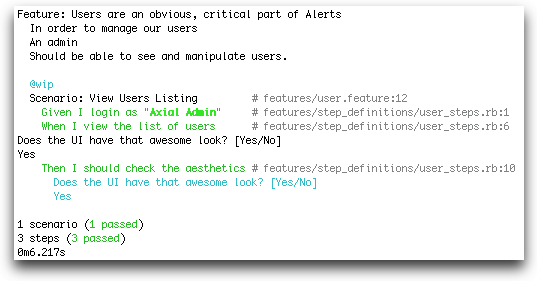there was some discussion over on the cucumber list about manual testing.
cucumber is great at BDD, but it doesn’t mean it is the only test technique (preaching to choir) we should use.
i have learned it is critical to understand where automated tests shine, and where human testing is critical — and to not confuse the two.
as far as cuking manual tests, keeping the tests in one place seems like a good advantage (as described in Tim Walker’s cucum-bumbler wiki <g>).
the cucumber “ask” method looks interesting. maybe your testers could use the output to the console as-is, or (re-)write your own method to store the results somewhere else/output them differently.
From the cucumber code (cucumber-1.1.4/lib/cucumber/runtime/user_interface.rb):
# Suspends execution and prompts +question+ to the console (STDOUT). # An operator (manual tester) can then enter a line of text and hit # <ENTER>. The entered text is returned, and both +question+ and # the result is added to the output using #puts. # ... def ask(question, timeout_seconds) ...
Sample Feature:
... Scenario: View Users Listing Given I login as "Admin" When I view the list of users Then I should check the aesthetics
Step definition:
Then /^I should check the aesthetics$/ do
ask("#{7.chr}Does the UI have that awesome look? [Yes/No]", 10).chomp.should =~ /yes/i
end
The output to the console looks like this:
Thanks for the pointer, Matt!
[notice]NOTE: it doesn’t play well with running guard/spork.[/notice]
The question pops up over in the guard terminal 🙁
Of course, if you are running a suite of manual tests, you probably don’t need to worry about the Rails stack being sluggish :-p
Spork server for RSpec, Cucumber successfully started
Running tests with args ["features/user.feature", "--tags", "@wip:3", "--wip", "--no-profile"]...
Does the UI have that awesome look? [Yes/No]
Yes
ERROR: Unknown command Yes
Done.

